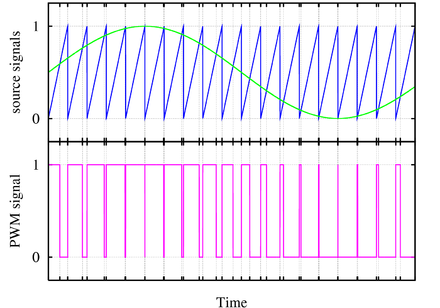Pulse width modulation
The pulse width modulation (short PDM ; pulse length modulation PLM ; pulse width modulation , PWM , pulse width modulation , PWM , subharmonic method ) is a modulation type switches in which a physical size (e.g., electrical voltage.) Between two values. The duty cycle of a rectangular pulse is modulated at a constant frequency , i.e. the duration of the pulses that form it .
modulation
A pure pulse duration modulated signal is generated, for example, by comparing a linearly increasing or decreasing signal (triangular or sawtooth voltage) with the analog input signal, which, depending on its value, lies above it for a short or a long time. At the intersection points, the output signal is switched between two logic levels . Like a digital signal, it has the advantage that it can only take on - here: two - discrete values (see below under areas of application ) , but its duty cycle can be changed continuously, i.e. H. not time-discrete.
A simpler possibility is to influence one of the time constants of an astable multivibrator with the input signal. Since the other time constant does not change proportionally, a mixture of pulse duration and frequency modulation is obtained , which is important depending on the application.
Suitable counter / comparator circuits are used to generate a PDM signal from digitally available data (e.g. engine control). Many microcontrollers already contain PDM modules directly or support their implementation through suitable timer functions.
Demodulation
A PDM signal is generally demodulated using a low pass . The resulting demodulated technical variable corresponds to the equivalent value and thus the mean height of the area below the modulated variable, determined mathematically from the integral over a whole number of periods, divided by the duration of the integration.
A clear example of this type of modulation is a switch that is used to switch a heater on and off continuously. The longer the switch-on time compared to the period, the higher the average heating output. The temperature of the heated building can only follow the switching on and off process comparatively slowly; its thermal inertia results in the necessary low-pass behavior for demodulation .
Areas of application
Pulse duration modulation is used to transmit information and also often to control the conversion of energy in a technical system.
measuring technology
Pulse duration modulation is often used to transmit analog measured values from sensors over long lines or wirelessly. Since there is a voltage drop on long lines, the transmission of the information in the form of a voltage level would result in falsification. When transmitting with pulse duration modulation, it is sufficient if the receiver can still distinguish between levels 1 and 0. The same applies to radio transmission, where the reception intensity is influenced by many environmental factors.
Control technology

In order to transmit analog signals over a digital route, the smoothing low-pass effect of a capacitance or inductance, e.g. B. a motor or a coil to control them with the help of a pulse train . In this way , analog devices (motors, heaters, etc.) can be controlled with digital circuits (e.g. microcontrollers ) that can only generate switched signals.
The control device does not necessarily have to be a digital device itself. For example, to control servos (transferring the setpoint ), an analog value is modulated by a rotary potentiometer and demodulated again in the servo. In general, this is used when both advantages of analog signals (high resolution, simple, robust, and interference-free technology) and advantages of digital signals (constancy, simple, efficient amplification) are required.
A control via PDM is used for the purpose of changing the speed of newer housing and CPU fans .
Another application example is dimming using PDM control. This technology is used in particular for light-emitting diodes (LEDs) , such as are often used as background lighting in cell phones or also in cockpit displays or brake lights in newer motor vehicles. If the switch-on and switch-off times are sufficiently short, the human eye only perceives the average luminosity so that it can be controlled linearly with the duty cycle. It is important to ensure that the clock frequency is set sufficiently high (e.g. 10 kHz) so that the eye cannot perceive any fluctuations in brightness (flickering) even when moving quickly. At high switching frequencies, the energy of a single pulse remains small in relation to the heat capacity of the emitting chip. The short-term peak temperature of the component during the pulse therefore remains at high switching frequencies close to the temperature that corresponds to the average power of the PDM signal. This is particularly advantageous for temperature-sensitive consumers such as high-performance light-emitting diodes. A low-pass filtering is not desired when controlling LEDs, since the color and efficiency are current-dependent and the luminosity is highly non-linearly dependent on the operating current.
Power electronics
The mean value of a voltage can be continuously reduced proportionally to the duty cycle using PDM. The setting of the reduced voltage is possible with relatively low power loss, since the circuit breakers (except in the switching moments) are only operated in two states: fully blocking (only leakage current at full voltage) or fully switched (only forward voltage at full amperage). This means that PDM is also important in power electronics .
Areas of application are DC choppers , frequency converters or electric motors , inverters for resistance spot welding , heating elements , dimmers , switched-mode power supplies , class D amplifiers and electronically commutated fans .
Analog-to-digital converter
A pulse duration modulated signal can be processed directly by digital electronics, e.g. B. by means of a binary counter and a higher frequency counting cycle. To record the pulse duration, the counter is set to 0 on the positive edge and read on the negative edge (value N 1 ). The pulse period must be constant, best derived from the same counting cycle by counting up to N 2 .
A similar procedure is used, for example, on the joystick connection (control stick) on the sound card of PCs (whereby the start of the impulse comes from the program).
Digital-to-analog converter
Another area of application is with digital-to-analog converters in measurement technology and for sound generation e.g. B. in synthesizers or CD players .
Communications engineering
Pulse duration modulation is used for the wireless transmission of physical quantities ( telemetry ) and for the energy-saving generation of amplitude modulation in large transmitters.
generation
From analog signals
A PDM signal can also be generated by means of an analog comparator by comparing the analog signal with a suitable carrier signal, as shown in the adjacent circuit diagram, whereby sawtooth and triangular signals are mainly used as modulation signals:
- Rising sawtooth signal (trailing edge modulated): The leading edge (rising edge) of the switching function is fixed and the position of the trailing edge (falling edge) is modulated.
- Falling sawtooth signal (leading edge modulated): The position of the leading edge of the switching function is modulated and the trailing edge remains fixed.
- Triangle signal for symmetrical modulation: With this type of modulation, the positions of both edges of the switching function are modulated. If the nominal value changes only slightly within a carrier period, the two switching edges are approximately symmetrical to the vertices of the triangular signal.
Another possibility for generating pulse duration modulation is a multivibrator , in which the duty cycle can be changed by a variable resistor or capacitor.
To determine the pulse duration, it is assumed that the arithmetic mean value of the signal to be modulated in a pulse period should exactly correspond to the equivalent value of the PDM pulse train. Both function curves (analog signal and PDM signal) therefore have the same voltage-time area in a pulse interval for a voltage signal.
From digital signals
Suitable counter / comparator circuits are used to generate a PDM signal from digitally available data (e.g. engine control). Many microcontrollers already contain PDM modules directly or support their implementation through suitable timer functions. In reverse of the analog-digital converter described above, the values N 1 and N 2 are specified for a given clock frequency , whereby the pulse duration t 1 and the period duration t 2 are set.
Problems in practice
A considerable problem when using the PDM method in practice is the formation of harmonics (also known as harmonics). These are formed as multiples of the modulation frequency and can lead to undesirable side effects such as noise generation, heating and problems with electromagnetic compatibility in the inductances controlled by PDM . This can be remedied by compensation by means of a connected capacitance or by changing the modulation frequency of the PDM. Typical applications that also deal with this problem are frequency converters or chopper control .
Advantages of pulse duration modulation
The advantage of the PDM signal is that it is formed by two voltage levels (low and high level). If a PDM generator is implemented in terms of circuitry using bipolar or MOS transistors or IGBTs , these can - in contrast to a generator with continuously (analog) variable voltage - work in low-loss switching mode. The two voltage levels of the square wave signal correspond to two logic levels, but they do not represent digits of a binary code . The information is contained in the analog pulse duration ratio. Signal amplifiers can even be implemented at PDM frequencies in the lower kilohertz range up to the upper kilowatt range. In electronics, amplifiers based on the PDM principle are known as class D amplifiers (class D, digital amplifiers).
See also
Web links
- Article on Roboternetz.de (German)
swell
- ↑ DIN 5483-1: 1983 - Time-dependent quantities: Name of the time-dependency. No. 7.3
- ↑ Karsten Block, Peter Busch, Ludger Erwig, Franz Fischer, Wilken Pape, Manfred Weißgerber: Electrical trades. Learning areas 9–13. Energy and building technology. 1st edition. Bildungsverlag EINS, Troisdorf 2006. ISBN 978-3-427-44464-0 . Pp. 216 ff., 253 ff., 304.
- ↑ IEC 60050, see DKE German Commission for Electrical, Electronic and Information Technologies in DIN and VDE: International Electrotechnical Dictionary



